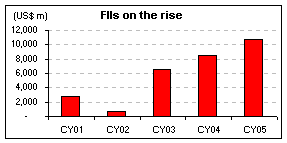Stockmarkets: The macro view...
The Indian stock market express continues to chug along, crossing various milestones along the way. The optimism has been fuelled by a robust Indian economy, strong demand and no dearth of liquidity in the markets. That said, despite the buoyancy on the bourses, developments in the global market (including the Fed rate hike) does prompt us to examine certain issues at the macro level, which we believe should be kept in mind by investors.
The Fed does it again: The US Fed has increased its benchmark interest rate by 25 basis points (0.25%) to 5%, which effectively means that the rates have been raised for 16 times in the past 22 months beginning June 2004. Investors should note that with rising US interest rates, equity money flows into emerging markets like India could be impacted in the medium term. The US 10-year yield has already crossed the 5.2% mark and further a rise cannot be ruled out. In such a scenario, a foreign investor has an option to invest in a security, which assures him more than 5% return (almost risk-free) versus taking a emerging market bet (including India).
Trade deficit widens: India's burgeoning trade deficit continues to remain a cause for concern. During April 2005 to February 2006, India's trade deficit stood at US$ 37.4 bn and was higher by 51.7% than the previous year (US$ 24.7 bn) (Source: RBI). What is pertinent to note is that while exports posted a strong growth of 26.6% YoY during the said period, they still lagged imports, which grew by 33.1% YoY. It must be noted that GDP growth at around 8% and strong capital goods imports have kept imports buoyant and consequently, a rise in the trade deficit burden.
 Paradoxical rupee:A current account deficit generally exerts downward pressure on the rupee, which in turn makes imports expensive, thus enabling in curbing the same. What has happened in the past couple of years is the opposite. The rupee has been on an appreciating trend since breaching the Rs 46 levels against the greenback in May 2004 (barring December 2005, wherein it once again depreciated to Rs 46.30 levels against the dollar). One of the main reasons why the rupee has appreciated despite the trade deficit is the surge of FII inflows in to the country. In 2004 and 2005, net cumulative FII inflows amounted to US$ 8.5 bn and US$ 10.7 bn respectively. In the Jan-May 2006 period itself, FIIs have pumped in money to the tune of US$ 5 bn in Indian equities (Source: SEBI). The other major reason for the appreciation is the fact that the greenback is weak (not that the rupee is strong).
Paradoxical rupee:A current account deficit generally exerts downward pressure on the rupee, which in turn makes imports expensive, thus enabling in curbing the same. What has happened in the past couple of years is the opposite. The rupee has been on an appreciating trend since breaching the Rs 46 levels against the greenback in May 2004 (barring December 2005, wherein it once again depreciated to Rs 46.30 levels against the dollar). One of the main reasons why the rupee has appreciated despite the trade deficit is the surge of FII inflows in to the country. In 2004 and 2005, net cumulative FII inflows amounted to US$ 8.5 bn and US$ 10.7 bn respectively. In the Jan-May 2006 period itself, FIIs have pumped in money to the tune of US$ 5 bn in Indian equities (Source: SEBI). The other major reason for the appreciation is the fact that the greenback is weak (not that the rupee is strong).
Oil spurts: The surge in crude oil prices over the years is not a surprise to anyone (currently over US$ 70 a barrel mark). This is certainly not good news for India since it imports around 70% of the oil that it consumes. During April 2005 to February 2006, while non-oil imports posted a growth of 26.8%, oil imports increased by 49% due to the steep rise in international crude oil prices (Source: RBI). A US$ 10 per barrel rise in crude prices is enough to shave off nearly 1% from the GDP growth rate of emerging economies like India. This is in sharp contrast to advanced economies, which would witness a 0.25% decline in their GDP growth rate!
To sum up... The Indian stock markets have been awash with liquidity (domestic and FIIs). That said, with current valuations looking stretched and with the US Fed not exhibiting signs of halting the rate hiking process, whether the current rally will sustain remains to be seen. While we do not want to be the harbingers of doom, we nevertheless advise investors to exercise caution while investing in stocks at current levels.